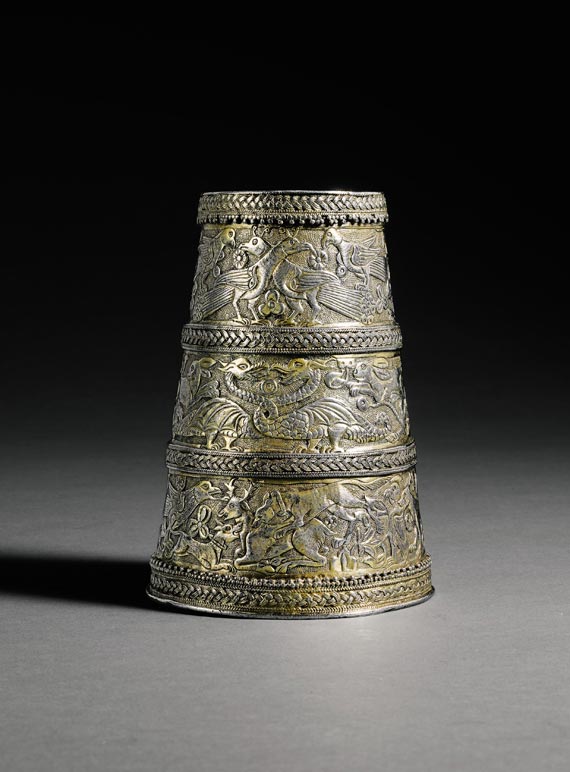
Sotheby’s Sale ‘An Eye for Opulence: Art of the Ottoman Empire’
Apr 24, 2012 Art Auction
The single owner sale is comprising a broad selection of works across a variety of media, spanning more than four hundred years of Ottoman art from the 15th to the 19th century. In addition to Iznik ceramics, manuscripts, silverware, decorative arts and textiles, the sale will also include a number of European paintings and Turqueries, reflecting artistic exchanges between the Ottoman Empire and Europe, and the West’s fascination with the 'exoticism' of the Ottoman court. Comprising 254 lots, this important private collection is estimated to realise in excess of £3.5 million.
Edward Gibbs, Senior Director and Head of Sotheby’s Middle East Department, said: The collection presented for sale is the result of over thirty years’ searching and selection on the part of its owner, whose enviable level of connoisseurship, gained from many years of studying the various forms of Ottoman art, is reflected in the mature and sophisticated array of objects, textiles and paintings to be offered. 'An Eye for Opulence: Art of the Ottoman Empire' will present opportunities for both collectors of Ottoman art as well as those interested in great design and sumptuous decoration.
Located at the crossroads of East and West, the Ottoman Empire absorbed a diverse range of influences, including Chinese, European and Persian, to produce a distinctive and coherent artistic language throughout a range of decorative arts. Ottoman expansion into Eastern Europe and subsequent access to the silver mines of the Balkans between the 14th and 16th centuries led to a rich and skilled tradition of Ottoman silverware; whilst the tiles, dishes and other ceramic objects made at Iznik in northwestern Anatolia have long been recognised as one of the greatest achievements of Ottoman art and even a significant moment in the history of world ceramics. In the later Ottoman period, the production of decorative arts continued to flourish with the introduction of both rococo and baroque elements signalling an increasingly open attitude to all things European in the 18th and 19th centuries.
Image above: A rare Iznik Blue and White 'Golden Horn' Jug, Turkey, circa 1530-40 / ESTIMATE 250,000-350,000 GBP / Courtesy of Sotheby's>
The collection of Orientalist paintings is rich in works from the 16th to 19th centuries, including topographical landscapes of Istanbul, genre scenes, and portraits of Ottoman notables. Highlighting the auction will be a 17th century North Italian School profile portrait of Sultan Murad I (r.1359-89) - with an inscription noting his assassination - estimated at £150,000-200,000. Also included in the sale is a Calligrapher’s Chest (Turkey, second half of the 16th century) which is estimated at £40,000 - 60,000, of rare design and quality. The selection includes a rare Iznik Polychrome Dish Depicting a Peacock, circa 1580, similar to the celebrated Iznik dish in the Louvre, which carries an estimate of £30,000 – 50,000. A rare Ottoman Silver Tankard (Turkey, 16th century) carries an estimate of £100,000 – 150,000, and a Pair of Imperial Diamond-Mounted Mother-of-Pearl and Coral Spoons (Turkey, 18th/19th century) is estimated at £8,000 – 12,000. The selection of textiles included within the collection represents all aspects of the woven and embroidered traditions of Ottoman textiles, from the 16th to the late 19th century. Examples include voided velvet yastik, embroidered quilt covers and bohca, delicate silk and metal-thread embroidered towels, and 16th and 17th-century brocades. *Estimates to not include buyer’s premium For more information please visit SOTHEBY'S North Italian School, Portrait of Sultan Murad I / ESTIMATE 150,000-200,000 GBP / Courtesy of Sotheby's
North Italian School, Portrait of Sultan Murad I / ESTIMATE 150,000-200,000 GBP / Courtesy of Sotheby's A rare and important Ottoman Silver cup and cover, Turkey, first half 16th century / ESTIMATE 100,000-150,000 GBP / Courtesy of Sotheby's
A rare and important Ottoman Silver cup and cover, Turkey, first half 16th century / ESTIMATE 100,000-150,000 GBP / Courtesy of Sotheby's A fine Ottoman Silver-Gilt Tankard (hanap), Balkans, circa 1550 / ESTIMATE 60,000-80,000 GBP / Courtesy of Sotheby's
A fine Ottoman Silver-Gilt Tankard (hanap), Balkans, circa 1550 / ESTIMATE 60,000-80,000 GBP / Courtesy of Sotheby's
Comments
Add a comment